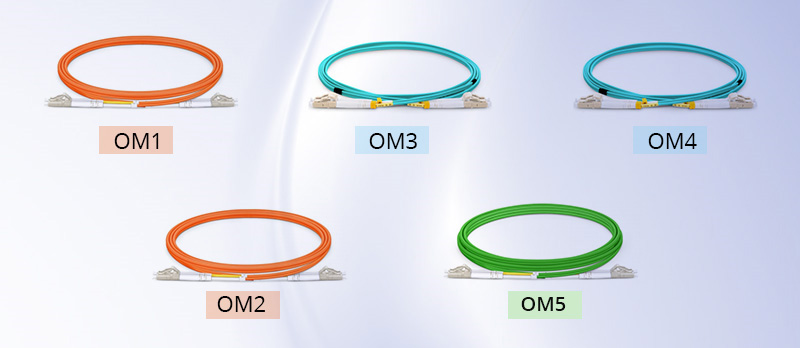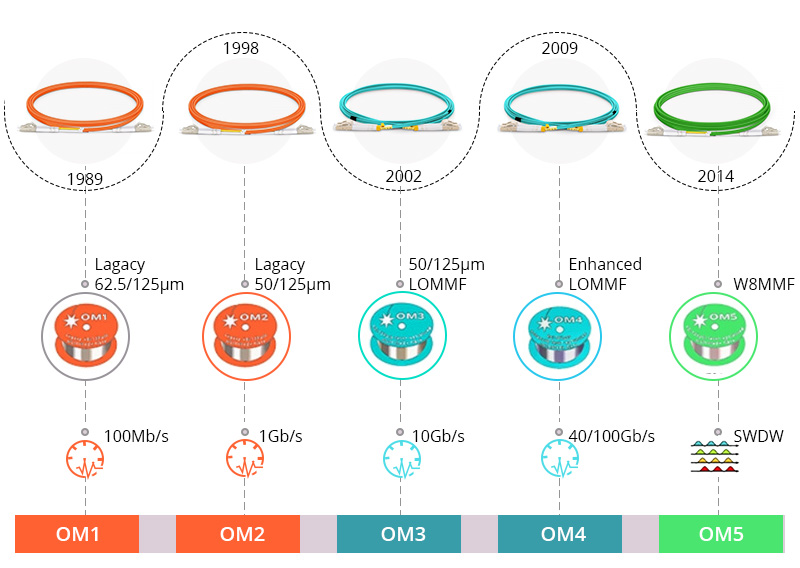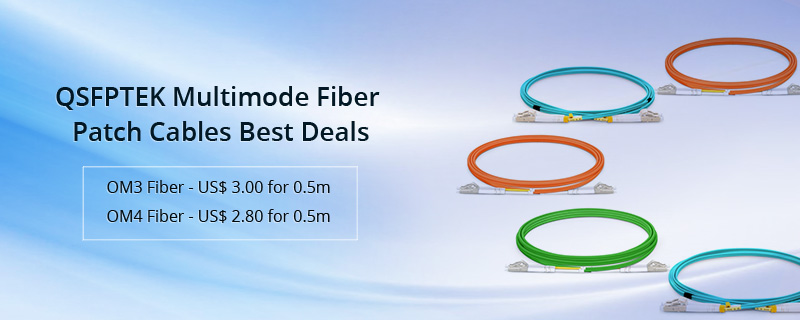OM1 OM2 OM3 OM4 OM5 Multimode Fiber Types: What is the Difference?
Various fiber optic cable types are found in the data transmission and telecommunication industry, say multimode fiber vs single-mode fiber patch cable (breakdown by transmission modes). Multimode fiber with short reach is typically used in LANs such as in-building connections and campus networks. OM1 fiber, OM2 fiber, OM3 fiber, OM4 fiber, and OM5 fiber are currently five multimode fiber types in the market. This post is a comprehensive OM1 OM2 OM3 OM4 OM5 comparison to illustrate what's the difference between OM1 OM2 OM3 OM4 OM5.

Figure 1: OM1 OM2 OM3 OM4 OM5 multimode fibers
What is OM1 OM2 OM3 and OM4 OM5?
OM1 OM2 OM3 OM4 OM5 are the names of Iteration of multimode fiber types. "OM" is the abbreviation for Optical Multimode. The Arabic numerals can be regarded as the order of publishing for different generations of multimode fiber standards. In chronological order, the larger the number, the latest release time. OM1 fiber is primeval while OM5 fiber is the latest version. Let's dive into OM1 OM2 OM3 OM4 OM5 fiber to better understand each multimode fiber type.

Figure 2: Five multimode fiber types: OM1 OM2 OM3 OM4 OM5 overview
OM1 Fiber
OM1 fiber usually utilizes an orange jacket color and LED light source for the light source. It is also called 62.5/125μm OM1 as it has a fiber core size of 62.5μm and a cladding diameter of 125μm. Though OM1 cable supports 10Gb Ethernet, it can only reach up to 33m. Typically, OM1 multimode fiber is most used in 100Mbit/s Ethernet applications with a 200MHz-km Overfilled Launch (OFL) bandwidth over 850nm and 500MHz-km bandwidth limitation via 1300nm.
OM2 Fiber
Similarly, OM2 fiber also comes with an orange jacket and LED source. What varies is the fiber core diameter narrow to 50μm. It supports running up to 10 Gbit/s within 82m. However, OM2 multimode fiber is most commonly applied in 1G (1000Mbps) Ethernet. Both wavelengths of 850nm and 1300nm are available for OM2 cable at an OFL bandwidth of 500MHz-km.
OM3 Fiber
Both multimode OM3 and OM4 have aqua color-coded jackets and 50μm core diameter. OM3 fiber is Laser optimized multi-mode fiber (LOMMF), designed for use with 850 nm Effect laser launch bandwidth VCSELs. It enables 40G and even 100G Ethernet applications up to 100m transmission distance and is typically used in 10 Gigabit Ethernet for within 300m short-distance applications. Minimum Modal Bandwidth (MBW) of OM3 cable with VCSEL source has an Effect laser launch bandwidth of 2,000 MHz-km at 850nm wavelength.
OM4 Fiber
OM4 fiber is also Laser-optimized for using 850nm VCSEL. It is specified to own a 4,700 MHz-km Effect laser launch bandwidth at 850 nm. Compared to the OM3 fiber cable, the OM4 cable support a longer distance at the same data rate. It reaches up to 400m at 10G and 150m at 40G/100G Ethernet. Multimode OM4 fiber cable is backward compatible with OM3 multimode fiber.
OM5 Fiber
OM5 fiber shares the same core diameter with OM2 OM3 OM4, and its optical source, minimum MBW for 850 nm is identical with OM4 multimode fiber. OM5 cable is compliant with OM4 specification at 850 nm. What differentiates OM5 MMF is that it is designed for Wide Band Multimode Fiber (WB MMF) to include extra bandwidth beyond 850 nm for longer reach using Short wavelength division multiplexing (SWDM), which uses four WDM wavelengths across the 850 nm to 940 nm range (850 nm, 880 nm, 910 nm, and 940 nm) to achieve 4x25GbE. The jacket of OM5 fiber color is lime green officially.
OM1 OM2 OM3 OM4 OM5 Comparison
Now that we have an overview impression about OM1 OM2 OM3 OM4 OM5 multimode fiber. Physically it is easy to identify them, then what is the difference between OM1 OM2 OM3 OM4 OM5 to set each apart from the other functionally? In this part, we will elaborate on the main difference in their functional features in several aspects such as bandwidth, wavelength, maximum speed, and transmission distance, etc.
Bandwidth & Wavelength
Bandwidth is the maximum rate of data transfer across a given path within a unit of time. The higher the bandwidth, the more data capacity received per second. OM1 OM2 OM3 OM4 OM5 all have their minimum Modal Bandwidth (MBW) requirement. Further, there are two measurements for MBW - Overfilled Launch (OFL) bandwidth vs effective modal bandwidth (EMB). OFL is with an LED source, EMB is with a VCSEL Laser source. OM1 and OM2 are specified OFL only while laser-optimized OM3 OM4 and OM5 support both measurements.
MMF Minimum Modal Bandwidth (MHz-km):
Taking OM3 MMF as an example, the table shows it has an overfilled launch bandwidth of 1,500 MHz*km at 850 nm, 500 MHz*km at 1300 nm and owns an effective modal bandwidth of 2000 MHz*km at 850 nm.
Speed
Speed or data rate defines how fast the data information is transmitted within a unit of time. OM1 OM2 OM3 OM4 OM5 enables to run over different data rates, but each multimode fiber has different utilization cases. The most frequently used data rate and the maximum supported speed for each MMF are shown in the table below.
Distance
Distance delimits how far the OM fiber can reach when succeeding in delivering the data from one end to the other end within the acceptable range of link loss.
The maximum transmission distance varies at the different data rates. The table below shows the max distance OM1 OM2 OM3 OM4 OM5 multimode fiber can reach at a specific supported speed over multimode transceiver modules.
Note: The above max reach is defined using standard 100BASE-FX, 1000BASE-SX, 10GBASE-SR, 25GBASE-SR, 40GBASE-SR4 and 100GBASE-SR10 transceiver over multimode fiber. When using other transceivers, the distance may be different, such as:
▪ OM3 at 40G can run up to 240m via Duplex LC with 40GBASE-SWDM4, and 330 m QSFP+ eSR4.
▪ OM4 and OM5 can run up to 350m via Duplex LC with 40GBASE-SWDM4, and 550 m QSFP+ eSR4.
Loss Limit
Besides distance, there is a loss limit that should be taken into consideration when deploying multimode fiber in specific applications. For example, OM4 fiber can be used for 100GbE to run 150m, it can be feasible when fiber loss is under 1.5 dB.
Application
Cost
OM5 is the newest and most expensive multimode fiber type, which is best for high-speed applications requiring SWDM. OM4 is much cheaper and currently fits 40G/100G applications up to 150m (the same as OM5). For most SMBs and enterprises, 10Gb OM3 multimode fiber is the cost-effective solution to go for meeting the current 10GbE and future-proofing 40G/100G upgrade. OM1 and OM2 are the cheapest but almost fall into disuse for transmission limitations.
Hot Q&A on OM1 OM2 OM3 OM4 OM5 Compatibility
Mix use of multimode fiber and OM1 OM2 OM3 OM4 compatibility issue has aroused hot attention on forums. Here are hot questions and answers for them.
Q: What's the Principle Among OM1 OM2 OM3 OM4 Compatibility?
A: In general, it is okay to mix connect 50/125 (OM2/OM3/OM4) with higher performance to the lowered one. Because it is acceptable to attach different multimode fiber types with the same core diameter, say OM2 OM3 OM4 OM5 with 50/125 core size can be used with 50/125 (OM2/OM3/OM4/OM5). The problem here is that you should lower your expectations of performance it can achieve to the Inferior OM fiber. OM5 is backward compatible with OM4, and OM4 is backward compatible with OM3. If connecting OM3 to OM4 fiber, the best performance that can be expected might be that of OM3.
Q: Is OM1 compatible with OM3?
A: This question is broad, so the answer is - it depends. If removing OM1 fiber and using OM3 multimode fiber for fiber optic cable for data transmission, is feasible.
Q: Can you splice OM1 to OM3?
A: OM1 fiber is not recommended to connect with OM3 fiber for they have different core sizes. OM1 has a 62.5/125 core diameter whereas OM3 multimode fiber has a 50/125 core diameter. Though mix-use 62.5/125 (OM1) with 50/125 (OM2/OM3/OM4) is proved by companies like Corning, it is still not recommended in a single link by most equipment manufactures. They believe that severe loss may occur. It may work on one end but fail on the other end.

Figure 3: Multimode fiber deals at QSFPTEK, get quote!
Conclusion
To choose from OM1 OM2 OM3 OM4 OM5 multimode fiber types with cost-effectiveness and practicality, please refer to the above application and cost parts. QSFPTEK provides both OM3 MMF fiber, OM4 multimode fiber, and OS2 single-mode fiber at the industry's best price. To get a quote for a negotiated price, please contact QSFPTEK via [email protected].











